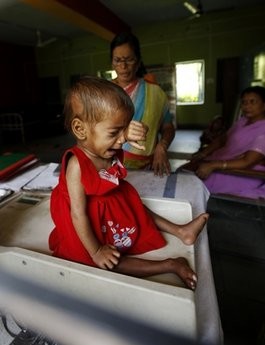The room is large and airy, the stone floors clean and cool — a welcome respite from the afternoon sun. Until your eyes take in the horror that it holds. Ten severely malnourished children — nine of them girls.
The starving girls in this hospital ward include a 21-month-old with arms and legs the size of twigs and an emaciated 1-year-old with huge, vacant eyes. Without urgent medical care, most will not live to see their next birthday.

They point to a painful reality revealed in India's most recent census: Despite a booming economy and big cities full of luxury cars and glittering malls, the country is failing its girls.
Early results show India has 914 girls under age 6 for every 1,000 boys. A decade ago, many were horrified when the ratio was 927 to 1,000.
The discrimination happens through abortions of female fetuses and sheer neglect of young girls, despite years of high-profile campaigns to address the issue. So serious is the problem that it's illegal for medical personnel to reveal the gender of an unborn fetus, although evidence suggests the ban is widely circumvented.
"My mother-in-law says a boy is necessary," says Sanju, holding her severely malnourished 9-month-old daughter in her lap in the hospital. She doesn't admit to deliberately starving the girl but only shrugs her own thin shoulders when asked why her daughter is so sick.
She will try again for a son in a year or two, she says.
Part of the reason Indians favor sons is the enormous expense in marrying off girls. Families often go into debt arranging marriages and paying elaborate dowries. A boy, on the other hand, will one day bring home a bride and dowry. Hindu custom also dictates that only sons can light their parents' funeral pyres.
But it's not simply that girls are more expensive for impoverished families. The census data shows that the worst offenders are the relatively wealthy northern states of Punjab and Haryana.
In Morena, a sun-baked, largely rural district in the heart of India, the numbers are especially grim. This census showed that only 825 girls for every 1,000 boys in the district made it to their sixth birthdays, down from an already troubling 829 a decade ago.
Though abortion is allowed in India, the country banned revealing the gender of unborn fetuses in 1994 in an attempt to halt sex-selective abortions. Every few years, federal and state governments announce new incentives — from free meals to free education — to encourage people to take care of their girls.
In Morena, a Madhya Pradesh state government program offers poor families with one or two daughters a few thousand rupees (a few hundred dollars) for every few years of schooling, and more than 100,000 rupees ($2,250) when they graduate high school.
But while a handful of Indian women have attained some of the highest positions in politics and business — from late Prime Minister Indira Gandhi to Pepsi CEO Indra Nooyi — a deep-rooted cultural preference for sons remains.
Even the government has accepted that it has failed to save millions of little girls.
"Whatever measures that have been put in over the last 40 years have not had any impact," India's Home Secretary G.K. Pillai said last month when announcing the census numbers.
In Morena's homes, villages, schools and hospitals lie some of the answers to why the country keeps losing girls.
In the district hospital's maternity ward, a wrinkled old woman walks out holding a just-born girl wrapped in a dirty rag like an unwelcome present. Munni, who uses only one name, is clearly unhappy. Her daughter-in-law has just given birth to her sixth girl in 12 years of marriage.
Will the daughter-in-law go through another pregnancy?
"Everyone wants boys. A boy takes care of you in your old age," Munni says.
























